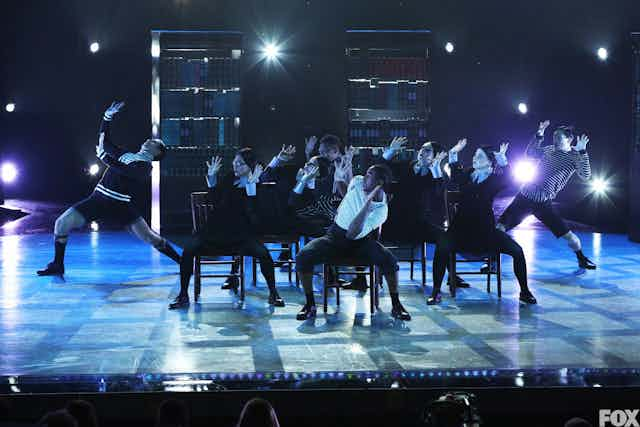Last month, the American reality dance competition show So You Think You Can Dance (SYTYCD) celebrated its ten-year anniversary. To mark the date, a special 60-minute episode called A Decade of Dance was aired, with re-stagings of some of the show’s most memorable dance routines by its most popular contestants.
These were interspersed with montages drawn from 11 seasons of the show: the good, the bad, the funny, and the often jaw-dropping athleticism and virtuosity of the dancers.
SYTYCD first screened – as you would have worked out from the above – in 2005, the same year the American version of Dancing With The Stars (season 21 of which will premiere next month) was launched. It marked the beginning of an exceptional decade of television shows and films focusing on dance.
It coincided with a new interest in and increasing production of blockbuster movies, as well as independent dance films (think the Step Up franchise and Frances Ha), dance documentaries (First Position and Pina), fictional dance television series (Bunheads and Dance Academy), reality TV shows (All the Right Moves, Bring it!) and dance web series (City.Ballet and The Legion of Extraordinary Dancers).
The past two years has also seen the increasing visibility of dance in music videos, not just as background noise but with dance content assuming centre stage (think all of Sia’s recent music videos), and dancers posting and promoting their own work on YouTube (check out choreographers WilldaBeast Adams and Tricia Miranda).
In short, this period has been a dance nerd’s wildest dream. Not only have shows such as SYTYCD (season 12 is now screening) made dance more visible and accessible outside a stage dance context. They have also, through their constant referencing of earlier popular screendance peak moments (think the Hollywood Musical of the 1930s to the 1950s, Fame, Flashdance, Footloose, and everything Bob Fosse ever did), commemorated the beauty and joy of these screendance works and their impact on spectators.
Created by American Idol producers Simon Fuller and Nigel Lythgoe, the show’s premise is to find “America’s favourite dancer” by a combination of open auditions, “Vegas Week” call back, and live performance shows.
While it is indeed indebted to television variety shows like Soul Train and American Bandstand, the structure of the format is much more aligned with the backstage musical and backstage dance film, in which a focus on auditions, rehearsals, and personal stories depict what British cultural theorist Angela McRobbie called, in Meaning and Motion (1997), “fantasies of achievement”.
Or, in Nigel Lythgoe’s words: “Now is the time when dancers should become stars again,” neatly hidden in an interactive televised dance competition format.
But what has prompted such an explosion in the popularity and production of popular screendance? And why do viewers love watching dance so much?
In contrast to a show such as Dancing With The Stars, there are no celebrities involved in the dance performances, and the dancers must be highly skilled, versatile, and talented to succeed.
It’s not enough to be proficient at one style either: they must demonstrate an ability to adapt between styles, usually variations of commercial hip hop choreography, International-style Ballroom, Broadway/Jazz, and commercial lyrical Contemporary.
The appeal of the show for spectators comes from exactly this emphasis on talent - the talent of both the dancers and the choreographers. It is about the kinaesthetic, felt experience of dance on screen, the ability of the kinaesthetic momentum of movement to … well, move, in its appeal to what English cultural theorist Dee Reynolds has called a spectator’s “inner dancer”.
Audiences are also drawn to the individual personalities of the dancers and the diversity of backgrounds and experience they embrace, not to mention the dance partnerships, some of which shouldn’t work but somehow do.
Think of Season 2, which saw West Coast Swing dancer Benji Schwimmer paired with African-American Hip Hop/Jazz Dancer Donyelle Jones for a Viennese Waltz. Benji and Donyelle have been one of the show’s most popular couples, lovingly referred to as “Benyelle”.
It’s a partnership that was purposely set up to fail by the producers, as Schwimmer revealed in a later interview but didn’t, because they won the affections of the audience.

Skin colour, gender, or sexual orientation become almost secondary to the contestant’s ability to play up their personalities with and for the camera. Among the most beloved and remembered contestants have been contemporary dancer Travis Wall (Season 2 white, openly gay), ballet dancer Danny Tidwell (Season 3, African-American, openly gay), freestyle dancer Stephen “tWitch” Boss (Season 4, African-American, straight), contemporary dancer Melanie Moore (Season 8, white, straight), and contemporary dancer Sasha Mallory (Season 8, African-American, openly lesbian).
This list is far from exhaustive and not meant as a sweeping generalisation of the inclusiveness of SYTYCD, which has been written about in more detail elsewhere.
Because there are many issues, particularly about the question of effeminate male dancing and what masculinity in dance means, the list shows, however, that viewing pleasures are far more complex than a simplified divide between the “black street dancer” and the “white upper/middle class ballerina”.
With the declining ratings of SYTYCD (it premiered in 2005 with 10 million viewers and versions of the franchise have been made in 25 countries) and the slower output of popular dance films and television shows, the question remains where will popular screendance go from here? Is it over? Have we enjoyed it all? Or are we moving towards screendance 2.0?

